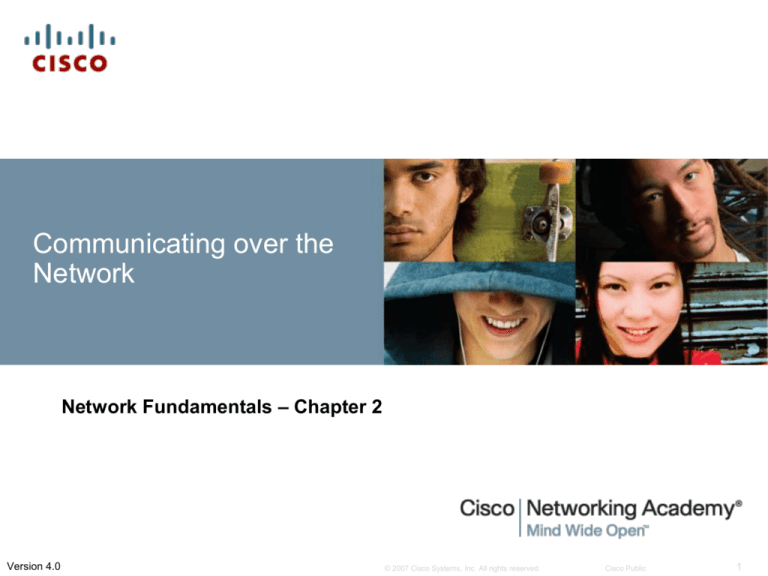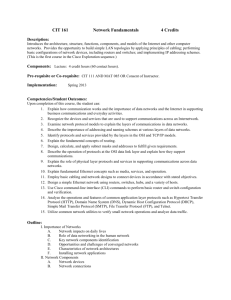
Communicating over the
Network
Network Fundamentals – Chapter 2
Version 4.0
© 2007 Cisco Systems, Inc. All rights reserved.
Cisco Public
1
Objectives
Describe the structure of a network, including the
devices and media that are necessary for successful
communications.
Explain the function of protocols in network
communications.
Explain the advantages of using a layered model to
describe network functionality.
Describe the role of each layer in two recognized
network models: The TCP/IP model and the OSI
model.
Describe the importance of addressing and naming
schemes in network communications.
© 2007 Cisco Systems, Inc. All rights reserved.
Cisco Public
2
Network Structure
Define the elements of communication
– 3 common elements of communication
• Message source
• The channel
• Message destination
Define a network
– Data or information networks capable of carrying many different
types of communications
© 2007 Cisco Systems, Inc. All rights reserved.
Cisco Public
3
Network Structure
Describe how messages are communicated
– Data is sent across a network in small “chunks” called
segments
© 2007 Cisco Systems, Inc. All rights reserved.
Cisco Public
4
Network Structure
Define the components of a network
– Network components
• Hardware
• Software
© 2007 Cisco Systems, Inc. All rights reserved.
Cisco Public
5
Network Structure
End Devices and their Role in the Network
– End devices form interface with human network &
communications network
– Role of end devices:
• Client
• Server
• Both client and server
© 2007 Cisco Systems, Inc. All rights reserved.
Cisco Public
6
Network Structure
Identify the role of an intermediary device in a data
network and be able to contrast that role with the role of
an end device
– Role of an intermediary device
• Provides connectivity and ensures data flows
across network
© 2007 Cisco Systems, Inc. All rights reserved.
Cisco Public
7
Network Structure
Define network media and criteria for making a network
media choice
– Network media – this is the channel over which a message
travels
© 2007 Cisco Systems, Inc. All rights reserved.
Cisco Public
8
Network Types
Define Local Area Networks (LANs)
– A network serving a home, building or campus is considered a
Local Area Network (LAN)
© 2007 Cisco Systems, Inc. All rights reserved.
Cisco Public
9
Network Types
Define Wide Area Networks (WANs)
– LANs separated by geographic distance are connected by a
network known as a Wide Area Network (WAN)
© 2007 Cisco Systems, Inc. All rights reserved.
Cisco Public
10
Network Types
Define the Internet
– The internet is defined as a global mesh of interconnected
networks
© 2007 Cisco Systems, Inc. All rights reserved.
Cisco Public
11
Network Types
Describe network representations
© 2007 Cisco Systems, Inc. All rights reserved.
Cisco Public
12
Function of Protocol in Network Communication
The importance of protocols and how they are used to
facilitate communication over data networks
– A protocol is a set of predetermined rules
© 2007 Cisco Systems, Inc. All rights reserved.
Cisco Public
13
Function of Protocol in Network Communication
Explain network protocols
– Network protocols are used to allow devices to communicate
successfully
© 2007 Cisco Systems, Inc. All rights reserved.
Cisco Public
14
Function of Protocol in Network Communication
Describe Protocol suites and industry standards
– A standard is a process or protocol that has been endorsed by
the networking industry and ratified by a standards organization
© 2007 Cisco Systems, Inc. All rights reserved.
Cisco Public
15
Function of Protocol in Network Communication
Define different protocols and how they interact
© 2007 Cisco Systems, Inc. All rights reserved.
Cisco Public
16
Function of Protocol in Network Communication
Technology independent Protocols
– Many diverse types of devices can communicate using the
same sets of protocols
– This is because protocols specify network functionality, not the
underlying technology to support this functionality
© 2007 Cisco Systems, Inc. All rights reserved.
Cisco Public
17
Layers with TCP/IP and OSI Model
Explain the benefits of using a layered model
– Benefits include
• Assists in protocol design
• Fosters competition
• Changes in one layer do not affect other layers
• Provides a common language
© 2007 Cisco Systems, Inc. All rights reserved.
Cisco Public
18
Layers with TCP/IP and OSI Model
Describe TCP/IP Mode
© 2007 Cisco Systems, Inc. All rights reserved.
Cisco Public
19
Layers with TCP/IP and OSI Model
Describe the Communication Process
© 2007 Cisco Systems, Inc. All rights reserved.
Cisco Public
20
Layers with TCP/IP and OSI Model
Explain protocol data units (PDU) and encapsulation
© 2007 Cisco Systems, Inc. All rights reserved.
Cisco Public
21
Layers with TCP/IP and OSI Model
Describe the process of sending and receiving
messages
© 2007 Cisco Systems, Inc. All rights reserved.
Cisco Public
22
Layers with TCP/IP and OSI Model
Explain protocol and reference models
– A protocol model provides a model that closely matches the
structure of a particular protocol suite
– A reference model provides a common reference for maintaining
consistency within all types of network protocols and services
© 2007 Cisco Systems, Inc. All rights reserved.
Cisco Public
23
Layers with TCP/IP and OSI Model
Define OSI
© 2007 Cisco Systems, Inc. All rights reserved.
Cisco Public
24
Layers with TCP/IP and OSI Model
Compare OSI and TCP/IP model
© 2007 Cisco Systems, Inc. All rights reserved.
Cisco Public
25
The OSI Reference Model
The OSI reference model
is the primary model for
network communications.
Allows you to view the
network functions that
occur at each layer.
It is a framework that you
can use to understand
how information travels
throughout a network
7 layers -- each of which
illustrates a particular
network function.
26
© 2007 Cisco Systems, Inc. All rights reserved.
Cisco Public
26
OSI – The Application
Layer
Provides network
services to the user's
applications.
It does not provide
services to any other
OSI layer
***Think of any network
application you use daily
27
© 2007 Cisco Systems, Inc. All rights reserved.
Cisco Public
27
OSI – The Presentation
Layer
It ensures that the
information that the
application layer of one
system sends out is
readable by the
application layer of
another system.
*** Think of any
common file formats
(JPEG, txt etc)
28
© 2007 Cisco Systems, Inc. All rights reserved.
Cisco Public
28
OSI – The Session
Layer
*** After you prepare your
data, you need to
establish the
communication channels
to send data
This layer establishes,
manages, and terminates
sessions between two
communicating hosts.
It also synchronizes
dialogue between the two
hosts' presentation layers
and manages their data
exchange.
29
© 2007 Cisco Systems, Inc. All rights reserved.
Cisco Public
29
OSI – The Transport Layer
Data will be segmented
and send to destination
device. Transport layer
of destination device
will reassemble them.
This layer handles
details of reliable
transfer. (ensures that
the data arrive
completely )
30
© 2007 Cisco Systems, Inc. All rights reserved.
Cisco Public
30
OSI – The Network Layer
Many paths to the
same destination.
So, which path to
follow?
Segmented data
needs address to
reach the destination
(network address)
This layer handle 2
above stated issues.
31
© 2007 Cisco Systems, Inc. All rights reserved.
Cisco Public
31
OSI – The Data Link Layer
It provides means for
exchanging data
frames over a
common media
To detect and
possibly correct
errors that may occur
in the Physical layer
Physical Addressing,
topologies and flow
control
32
© 2007 Cisco Systems, Inc. All rights reserved.
Cisco Public
32
OSI – The Physical Layer
It defines the electrical,
mechanical, procedural,
and functional
specifications for
activating, maintaining,
and deactivating the
physical link between end
systems.
Voltage levels, timing of
voltage changes, physical
data rates, maximum
transmission distances,
physical connectors, and
other, similar, attributes
defined by physical layer
specifications.
33
© 2007 Cisco Systems, Inc. All rights reserved.
Cisco Public
33
TCP/IP Model
Network Access: Detailing the components that
make up the psysical link and how to access it
34
© 2007 Cisco Systems, Inc. All rights reserved.
Cisco Public
34
Comparison
--Both have application
layers, though they include
very different services
--Both have comparable
transport and network
(Internet) layers
--TCP/IP combines the
presentation and session
layer issues into its
application layer
--TCP/IP combines the OSI
data link and physical layers
into one layer
--TCP/IP appears simpler
because it has fewer layers
35
© 2007 Cisco Systems, Inc. All rights reserved.
Cisco Public
35
Data Encapsulation
Build the data
Package the data
for end to end
support
(Segments)
The data is put
into a packet or
datagram that
contains a network
header with source
and destination
logical addresses
PDU: Transport layer: Segment,
Network: Packet, Data Link: Frame
36
© 2007 Cisco Systems, Inc. All rights reserved.
Cisco Public
36
Data Encapsulation
Each network
device must put the
packet into a
frame.
Network header: IP address (host),
Frame header: MAC address (physical
address)
The frame must be
converted into a
pattern of 1s and
0s (bits)
***Data
Segments
Packet Frames
Bits
37
© 2007 Cisco Systems, Inc. All rights reserved.
Cisco Public
37
Addressing in the Network
There are various types of addresses that must be
included to successfully deliver the data from a source
application running on one host to the correct
destination application running on another
Transport Layer (#4): to identify the processes or
services that are communicating within the end
devices
38
© 2007 Cisco Systems, Inc. All rights reserved.
Cisco Public
38
Addressing and Naming Schemes
Explain how labels in encapsulation headers are used
to manage communication in data networks
© 2007 Cisco Systems, Inc. All rights reserved.
Cisco Public
39
Addressing and Naming Schemes
Describe examples of Ethernet MAC Addresses, IP
Addresses, and TCP/UDP Port numbers
© 2007 Cisco Systems, Inc. All rights reserved.
Cisco Public
40
Addressing and Naming Schemes
Explain how labels in encapsulation headers are used
to manage communication in data networks
© 2007 Cisco Systems, Inc. All rights reserved.
Cisco Public
41
Addressing and Naming Schemes
Describe how information in the encapsulation header
is used to identify the source and destination processes
for data communication
© 2007 Cisco Systems, Inc. All rights reserved.
Cisco Public
42
Summary
© 2007 Cisco Systems, Inc. All rights reserved.
Cisco Public
43
© 2007 Cisco Systems, Inc. All rights reserved.
Cisco Public
44






